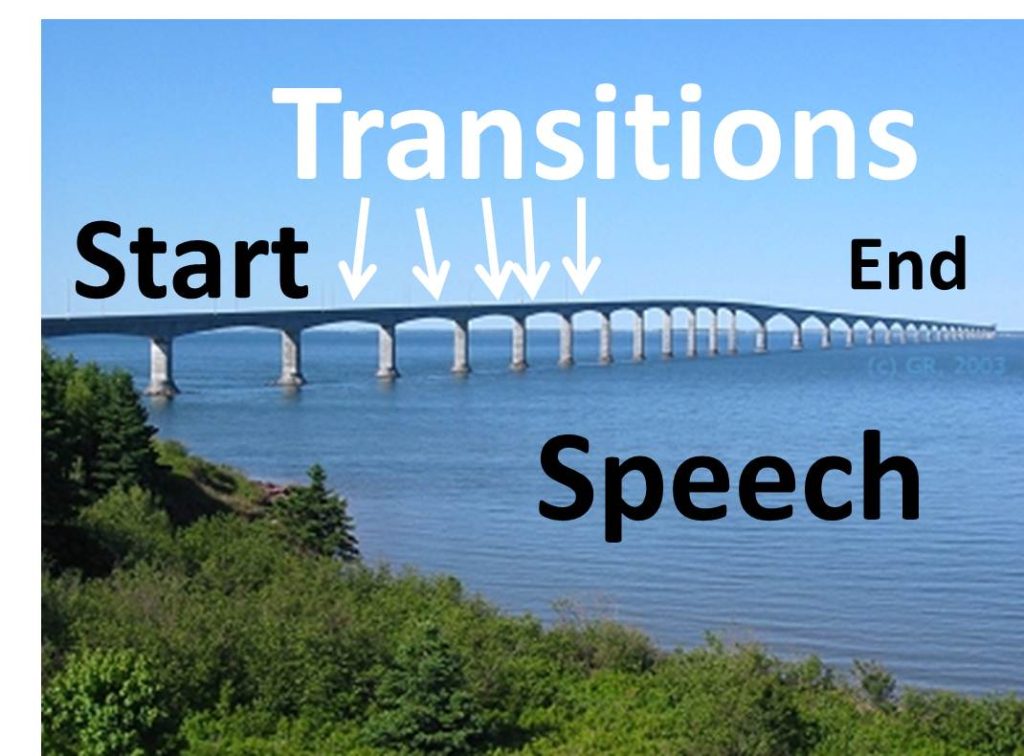Transitions help your speech flow smoothly as one unified, coherent presentation. They link from one part of your speech to the next.
A transition can be as simple as an extended pause. That’s right. Silence. Just be silent for a couple of beats and then go to your next point. You can accompany “movement” to your next point with physical movement on the platform to another position. Many speakers will start out in the center in the introduction and move off to the sides for the main points and then come back to the center for the conclusion.
A transition also can be a simple “signpost” such as “first . . . second . . . third.” Better signposting will include a number and a reminder phrase. So, instead of just saying, “Second . . .” it is better to say, “The second reason you want to use storytelling in speeches is . . .”
You also can use transitional words and phrases, such as “in addition to . . .” or, “Not only . . . but also . . .” and “in summary.”
More elegant transitions show the connection between the introduction and the body, between the main points and between the body and the conclusion.
There are two main ways to show connection in transitions: the mini-summary (or recap), which quickly sums up the point before moving to the next point, or the mini-preview which sets up the next point.
You can recap your point or points yourself, or ask the audience a question and get them to recap the point for you. You also can share a story or quote which summarizes your previous point or previews the next point.
I will sometimes highlight an important point in the recap: “If you take only one idea from my presentation today, make it this . . . “
2001 World Champion of Public Speaking, Darren LaCroix in his winning speech used the mini-preview quite effectively:
- Set up point 1 (a story): Dr. Goddard had a ridiculous idea.
- Point 1: Dr. Goddard story
- Transition phrase: I remember when I had a ridiculous idea.
- Point 2: My ridiculous idea story
The transition to the conclusion is important and different in that you have to indicate to the audience that you are coming to a close (so that it doesn’t seem abrupt). You can be obvious and say things like, “in conclusion” or “in closing” which is better than nothing or you could try a more elegant approach combining specific phrases (e.g. “Now that you can see how [solution] can work for you, let’s review why you would want to implement it . . .), with body movement (coming back to the center) and slowing your rate of speech, using more pauses.
Here’s a question on conclusions I’ve often heard . . . “Should I say ‘thank you?’” I suppose it is a matter of personal preference, and if you are in Toastmasters, you probably have heard that you shouldn’t. As for me, when I speak professionally, I almost always do. I sincerely appreciate my audience for allowing me to enter their world.


Do you have a written script of a closing statement after a sales presentation? Looking for written examples of closing statements after a sales presentation. I’m having a hard time with how I want to start my closing statement.
Thank you in advance for your attention to this request.
Lawrence–
Thanks for asking. I don’t personally have written scripts of closing statements that would be used in a general sales presentation. What I have found to be most useful is to talk with top producers in a given field and find out what they use to close–and record their words, which you can later transcribe and practice. In fact, if you can record entire sales presentations/conversations of top producers, you can learn a lot!
The other technique is ABC “Always Be Closing.” You may not need to go through the entire sales presentation to close. Get agreement on points throughout your sales presentation, then the final close is more natural.]
There are a lot of resources online, too, such as: http://www-rohan.sdsu.edu/~renglish/377/notes/chapt13/index.htm